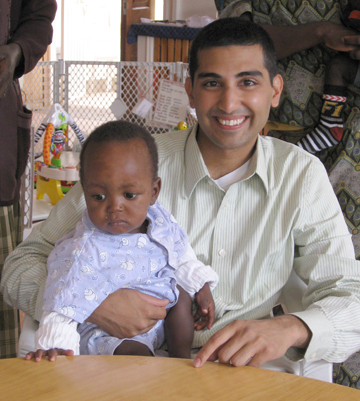Purdue Profiles: Sonak Pastakia

Sonak Pastakia, assistant professor of pharmacy practice, is team leader of the Purdue Pharmacy in Kenya program. Here, Sonak is at the Sally Test Pediatric Center in Kenya.
Sonak Pastakia, assistant professor of pharmacy practice and team leader of the Purdue Pharmacy in Kenya program, is taking his know-how beyond the pharmaceutical counter and launching sustainable care programs full time in Eldoret, Kenya.
As a pharmacist for Academic Model Providing Access to Healthcare (AMPATH), Pastakia recognized a need for chronic disease management in addition to the HIV care programs that were already in place. Along with helping to establish diabetes and anticoagulation care clinics, he trains students from Purdue and the University of Nairobi to direct long-term care systems.
In January, Pastakia received a grant from Purdue's Global Policy Research Institute for his proposal, which will address diabetes management in Kenya by developing training programs to teach patients to be their own community health providers.
How did you become interested in international health care?
Well, after my pharmacy studies, I did an HIV and infectious diseases residency and got my master's in public health with a focus on management and international health. At that point I was convinced I wanted to make international work the main bulk of my career, so I began looking for a job; however, the universal response I got was that nobody was really that interested.
Just as I was resigning myself to the conclusion that I'd have to prove myself in America before I would be able to work internationally, Purdue posted a position for an international faculty member to be stationed in Kenya.
Was Kenya where you preferred to work?
For me it didn't matter so much where it was. It was more about putting myself in a place where I could have as much impact on patient care as possible.
When I was a pharmacy resident, I had had a previous experience in Kenya where we went for one month, provided primary pharmaceutical care and left knowing the patients would no longer receive the medications and care they needed. Although many people who have this type of experience get their fill and think they made a great difference, I left with a very guilty feeling that I could not seem to shake.
Being part of an international program like that really made me want to come back and do it the right way. All the programs I work with now are designed with the primary intent of helping the Kenyan population in a sustainable way.
What is your favorite part of being able to work internationally?
Largely, my overarching favorite part is creating opportunities for people and watching them succeed. I think that is the biggest thing we can do. It is exciting to watch someone grow, build a career and help more people than they ever could have imagined.
Why did you decide to take your work in Kenya beyond the realm of pharmacy?
I try not to let my training and background dictate what I do. I let the patients and their needs lead me to my next project. My training was in HIV and infectious diseases, which is why getting involved with AMPATH made sense. When I realized HIV care was actually really good in Kenya because of the focused investment facilitated by President's Emergency Plan for AIDS Relief (PEPFAR), I began gravitating toward other areas that lacked infrastructure like diabetes and anticoagulation.
You also helped create the Tumaini Center for street kids in Eldoret. Why did you become involved in that?
Every time I would go into town there were hoards of street kids asking for money and just being bothersome. For me, just passing them and shooing them away left me with a very empty feeling. There was nothing I could do in that moment to help them. If I gave them food or money, older kids would beat them up for it.
So we created the center as an outlet for all of us to help them in a sustained way. It is so great to see them in the center acting like kids. When they are on the streets, they are often looked at in a subhuman type of way. But the center puts them in an environment where they can play, interact and be creative.
What has been your most memorable moment working in Western Kenya?
One of the most memorable moments was when we gave the street kids Polaroid cameras to take pictures of their lives. It's not memorable in a good way, but it is one of those moments that leaves an indelible mark. We displayed their pictures in an art exhibit format, and just seeing the differences between their lives on the streets and their lives at the Tumaini Center is a moment I will never forget.
Another thing that is very memorable to me is seeing the community support given to patients at the diabetes clinic. I can't remember a time when a patient over the age of 60 came to the clinic alone. They always have a family member or their whole community with them. This community investment in everyone's well-being is one of the stark contrasts between Kenyan and American culture that I think really emphasizes how well positioned Kenyan patients are to succeed if the infrastructure for care access is developed. It also helps highlight one of the many things I try to impart to my students as they return to the more individualistic American practice setting.
